Kubrick: Barry Lyndon part 6
SCENE 54. Barry Lyndon now enters its sixth act. Barry has been a love-struck goon, a British soldier, a fugitive, a Prussian soldier, a Prussian spy, and is now reborn, again, as a high-society gambler. We now find him at the side of his third surrogate father, the Chevalier de Balibari, as he practices his trade of cheating at cards.
How do we feel about Barry now? We’ve just smiled at him and the Chevalier pulling the wool over the Prussians’ eyes with an Ocean’s 11-level switcheroo. Now we see him, with white-powdered face and ultra-fancy dress, helping the Chevalier con a lord who is portrayed as a simpering, preening idiot. It feels to us like Barry has gotten a leg over this business of social climbing, and if he did so by being a liar, a cheat and a thief, well, we’re okay with that, because those rich snobs deserve what they get.
Where are our themes? Well, the narrator informs us that Barry has decided, now and forever, to live life as a gentleman, and he’s now at a gaming table in a royal court, so that’s our theme of social advancement. “Living as a gentleman,” of course, means lying and cheating, which is one of the more trenchant observations of Barry Lyndon. Love enters the scene in the form of Lord Ludd, who is playing against the Chevalier under the handicap of being distracted by numerous comely young royal personages, literally nibbling their fingertips fielding multiple kisses and whispered comments while trying, not very hard, to concentrate on the game, so distracted that he misses the oldest trick in the book, the Chevalier producing a card from up his sleeve. As for violence, Kubrick puts it in the cut as this scene sets up the violence and the next one pays it off.
SCENE 55. Kubrick, and the narrator, make the direct point here (pun unintended) that wealth is procured through deceit and maintained through violence. The Chevalier is the brains of the outfit, but Barry is the muscle, and if a highfalutin’ personage like Lord Ludd tries to weasel out of a gambling debt, Barry is the one who uses his natural-born fighting skills to secure payment. The implication is that the swordfight with Lord Ludd is just a miniature version of the Seven Years’ War or any other Napoleonic conflict — theft of resources secured through violence.
SCENE 56. Barry and the Chevalier abscond from Lord Ludd’s domain by coach, as the narrator informs us that, for all their cheating and fighting, Barry and the Chevalier don’t really profit much from their adventures. The narrator doesn’t reveal the specifics, but I assume that living in style — especially style one was not born to — is an expensive business. In any case, Barry is merely treading water in this social milieu, where he’s a pretender to class but not its owner.
SCENE 57. Barry decides (again, the narrator informs us, the scene is not dramatized) that what he really needs is to marry a wealthy, highly-placed lady, one married to a genuine knight of the realm. The movie’s visual debt to 18th-century painting is obvious, but its narrative debt is more elusive. There are a large number of scenes, like this one and the one before, that have little to no dramatic action at all; they are tableaus, with a story behind them, which the narrator supplies. In the 18th century there was a whole genre of paintings like this, called conversation pieces, where a moment from a narrative is presented and the full meaning of the image can’t be understood without knowing the dramatic underpinnings of it.
Like this one, for instance. To us, it looks like a family portrait. To its intended viewership, there are dozens of fashion and social cues that link it to a well-known story of its day. Narrative in Barry Lyndon often functions in the exact same way: we see our exquisitely composed image with its still figures, and it’s all narratively meaningless until our narrator gives us the image’s context.
In any case, as Barry and the Chevalier relax in a palace garden, along comes Lady Lyndon, a gorgeous young thing married to a gouty toad of a knight, mother to a nervous, clinging young viscount and employer of a tutor, the sour-faced Reverend Runt, who is something of a pretender himself, as the narrative will eventually reveal. Barry (the narrator tells us) has decided that there is no such thing as love (striking one of our themes, seemingly, from the record) but he will employ its counterfeit (that is, sex) to further his position in society.
SCENE 58. So Barry is now at the gaming table as the Chevalier steals Lady Lyndon’s money and Barry goes to work on stealing her heart. Reverend Runt is there, seemingly as a chaperone, to make sure Lady Lyndon doesn’t fall prey to scalawags. (He fails in this regard.)
What does Lady Lyndon see in Barry? We’ve barely glimpsed her husband Sir Charles Lyndon, but we can tell that he’s old, infirm and kind of a sourpuss. At her side at the card game is Reverend Runt, who, while younger and more agile, is even more of a sourpuss than her husband. The only other male in Lady Lyndon’s life we’ve seen is the young Viscount Bullingdon, who is, at best, a wet weed. So it’s easy to guess that Lady Lyndon sees in Barry “a real man,” which suggests a couple of things — either the European aristocracy is utterly devoid of “real men,” or Lady Lyndon sees Barry for exactly what he is, a middle-class Irish pretender, and doesn’t care, because she, too, knows that wealth and class are illusions.
Indeed, Lady Lyndon’s “true feelings” often go unexplored as the narrative continues, especially in regards to Barry’s open social climbing. Is she a porcelain doll in a glass case, unaware of Barry’s predations, or is she so love-starved that she knows about his schemes on her and doesn’t care?
SCENE 59. Lady Lyndon excuses herself from the gaming table and goes out for a breath of fresh air, which Barry interprets, correctly I think, as an invitation that he do the same. They meet out on the veranda of whatever grand palace they’re at, and Barry, without a word, takes her in his arms and kisses her. What makes the scene fascinating is that it’s an inversion of the gazebo scene with Nora. There, Nora beat Barry at cards (through cheating?) and demanded a kiss as payment. Nora was only looking for a bit of fun, but her actions turned Barry in a lovestruck goon. Now it’s Barry who is Nora, cheating at cards, then moving in for the kiss with Lady Lyndon, turning her into the lovestruck goon. It would have been great to see Barry, or the narrator, actually reflect on this parallel, that Barry, once the student, is now the teacher.
SCENE 60 & 61. The movie now gives us a brief, two-shot “falling in love” montage, as the narrator informs us that Barry now contrives to put himself at Lady Lyndon’s side at every available opportunity. First we see them going for a punt on a pond, and then we see them promenading in a grand royal garden. The two shots give us an idea of just how expansive and detailed this rarefied world of European aristocracy is, with its games of croquet, ladies fishing in fountains and exquisitely dressed folks taking their leisure. Even through Kubrick’s cold lens, it’s not hard to see the appeal of this closed-off high-tone playground.
SCENE 62. As the act closes, Barry “goes in for the kill,” confronting Lady Lyndon’s husband while he, yes, plays cards in a gaming spot or gentlemen’s club. There’s a character to the left of the screen, slouched asleep in his chair, who is a foreshadowing of where we’ll find Barry in a later, similar scene.
Here are our themes restated again: social climbing, in the form of Barry scheming, as Sir Charles puts it, to “step into my shoes” (another metaphor that will crop up again later). Love is present in its absence, as Barry has decided that love is antithetical to social advancement, and violence is here in its subtlest form: a vicious, insinuating chain of heavily-loaded lines that Barry uses to protest his innocence in regards to his designs on Lady Lyndon. His prodding of Sir Charles prompts Charles to respond with a much more direct threat of violence — he says that he’ll use his not-inconsiderable power to see Barry hanged.
Barry retreats, and Sir Charles promptly has a heart attack. He’s attended to by his fellow gentlemen, but the narrator informs us, in the most sideways way possible (reciting from an obituary), that Sir Charles soon dies. As the intermission presents itself, Barry has achieved the goal he’s set out for, but Kubrick does not give us the scene where he proposes to Lady Lyndon, or their wedding, or any moment of his satisfaction. Instead, he leaves us with the ailing Sir Charles, and even goes so far as to fade out the audio in the middle the narrator’s recitation. In a movie that denies the audience the most basic of cinematic storytelling conventions, Kubrick dares the audience to return to his story after leaving them with an ellipsis.
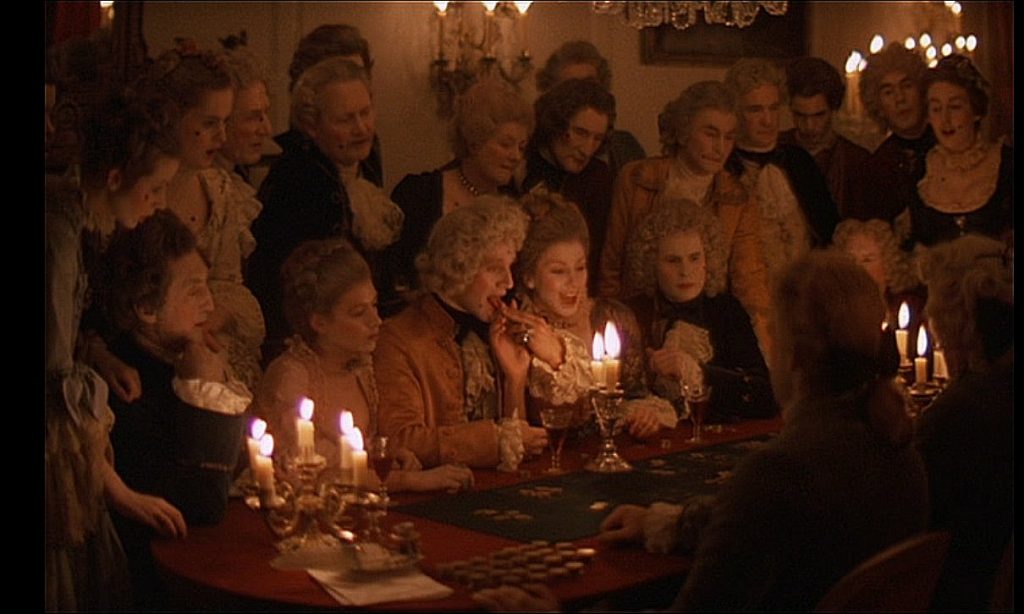
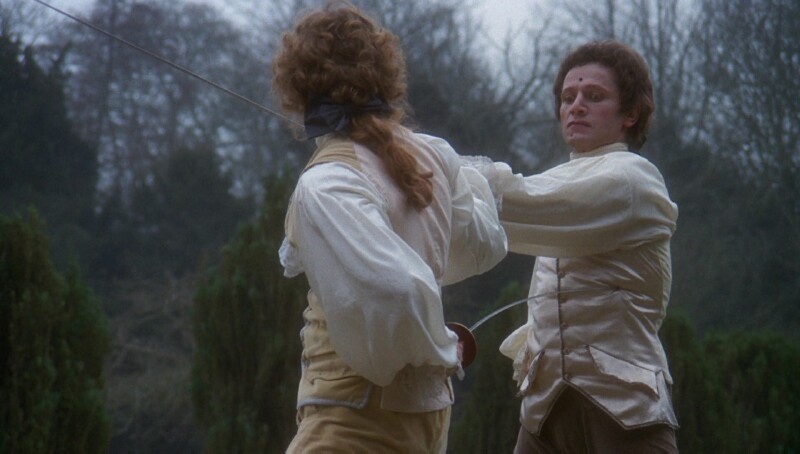
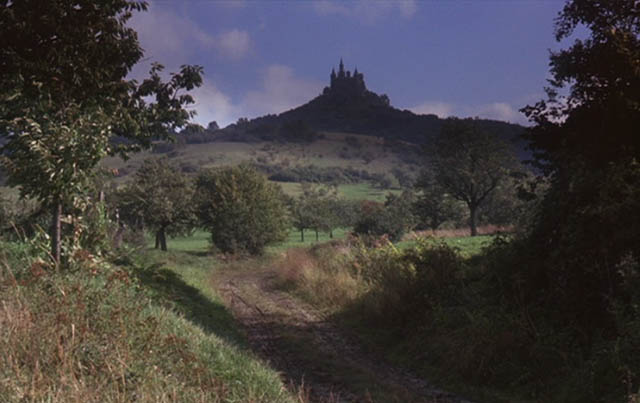
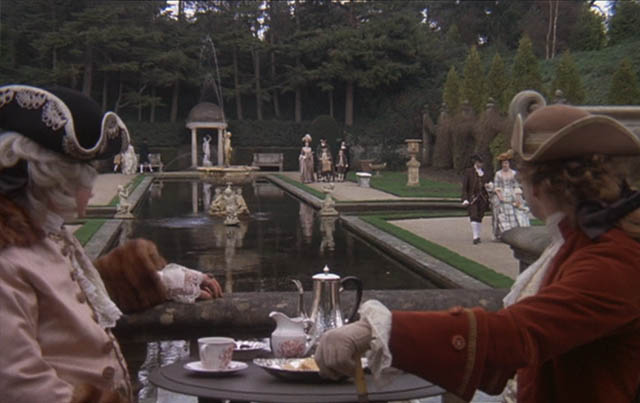

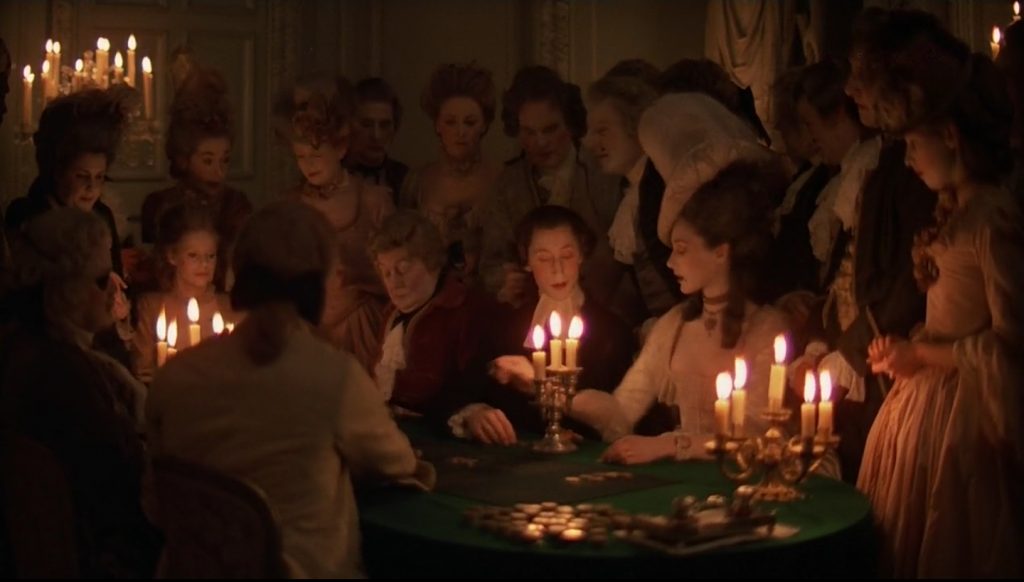
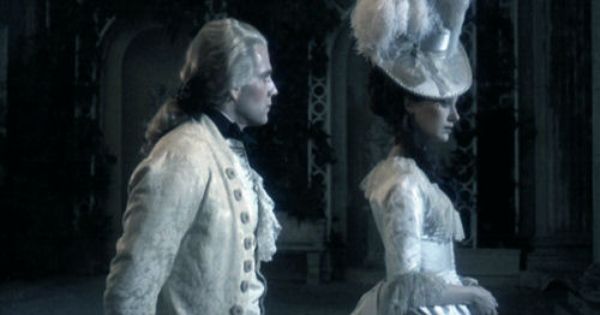
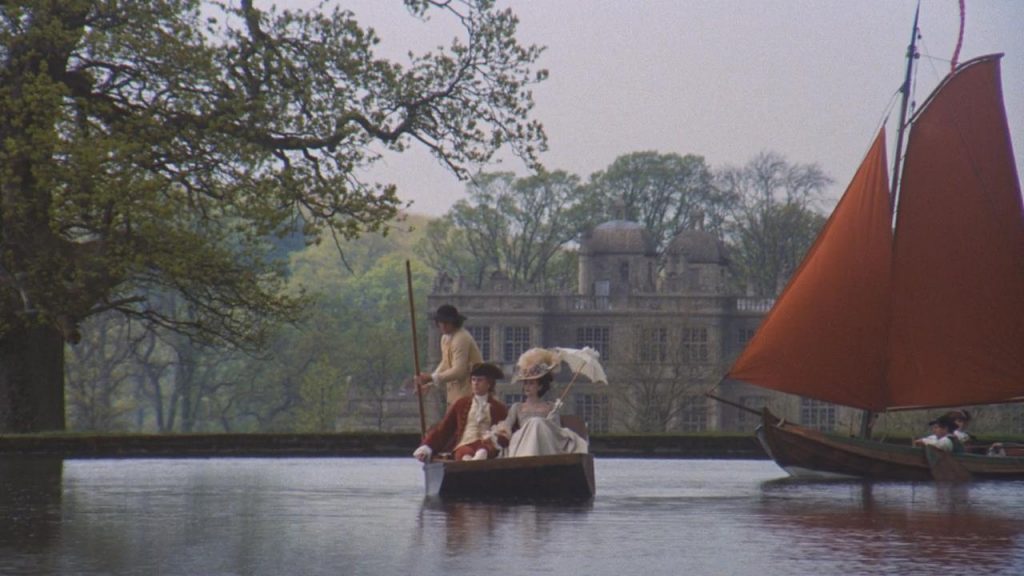
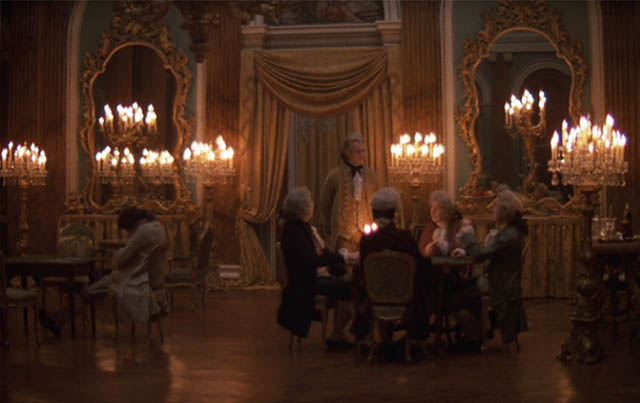
The “asleep in the chair” motif is interesting, and I think is more than a foreshadowing, more a clue to something. The first sleeper that I’ve noticed is seen very briefly in scene 57 alone at a table in the palace garden as the camera pans slowly to Barry. Many more “sleepers” appear from here until the end of the film, seemingly increasing in number. I have no idea what it means, but it feels deliberate.